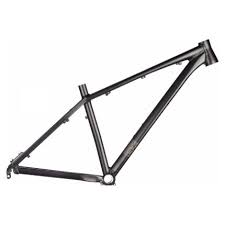INTRODUCTION
Quick Navigation
Mountain bikes share quite a few similarities with various other bicycles but are distinctive in their performance on rough terrains. They are often heavier and have more complex geometry than regular bikes to help them stand rough handlings. Mountain bike frames are built for speed and variety to suit different bike sizes.
Humans are of different lengths, and so are bikes. How tall a rider is will determine the bike frame they would get. The rider enjoys a comfortable and efficient ride when sized and selected correctly. The geometry of a bike that includes The Frame is one of the most important aspects to consider when getting a bike because it would ultimately affect how much you enjoy riding your mountain bike.
Bike frames are usually made from steel, titanium, carbon fiber, or aluminum, depending on the brand of bike. Most mountain bikes can accommodate tires of sizes 26 or 29 inches. The size of your mountain bike frame is determined by the length of the bike’s seat tube. Mountain bikes have a more petite frame than regular road bikes because they allow riders to move more and successfully ride on challenging terrain. The stand-over height of road bikes is higher than mountain bikes which makes the sitting position of the mountain bike more upright.
Types of Mountain Bike Frames
There are two primary classifications of mountain bike frames, and the choice of which is best is more of a personal preference. Most riders pick a frame they like the feel, and others get both to use as a substitute. The main mountain bike frame is:
- Hardtails: As the name implies, this frame favors a fully-stiff structure rather than a rear suspension. This frame is generally lighter than its counterpart and invariably less expensive. The hardtail mountain bike frame offers you the ease of speed and transfer of power while you ride; it is simply handled and lasts longer. The hardtail mountain bike frame comes in different types; some are designed to cater to all your riding needs, while others are for specific requirements.
- Suspension: The suspension mountain bike comes with a shock absorber, and it also allows the rear end of the cycle to move independently and ultimately soak up bumps that occur during rides. The Suspension mountain bike frame has various times the bike’s back end can travel. The suspension frame also has different types, of which some are full-sussers; that is, they are designed to take all road suspensions. Some other types focus on tailored suspension needs for cross-country or endure bike riding.
What To Measure For a Perfect Bike
Getting a perfect bike is beyond checking out the sizes by sight, which could be miscalculated. When correctly taken, two major measurements can get you a perfect-sized bike. Your total height and inside leg are the primary measurements you require to buy a perfect bike size. You can measure your height by standing erect against a wall and marking the top of your head, and you should take this measurement with your shoes off. You can use a measuring tape to measure the marked spot to the ground.
The second measurement, the inside legs, is taken to get an adequate stand-over height that would be comfortable for you. The stand-over length is the distance between the ground and top tube of the bike’s frame and is measured from your groin to the floor. You can now measure the distance between the bottom and the marked spot to get your inside leg measurement. The awareness of these two measurements would help guide you in buying a rightly sized bike.
How To Measure Bike Frame
The best way to do a thing is often knowing the right way to go about it. Bike frames are not simply crafted on a straight line, which requires detailed directions for measuring them. The length of your seat tube often determines the size of your bike frame; The seat tube length determines the minimum or maximum height of a rider, and it is vital when considering a bike’s geometry. The seat tube length is more than a reference point for indicating a bike’s S, M, or L. Two small bike frames would have distinct seat tube lengths to fit other riders, necessitating measuring the frame.
Steps To Measure a Bike
- Find the top of your seat tube. This top is located where the seat clamp holds down the seat post. It is expedient to know where the top of your seat tube is to get a perfect measurement of the entire bike frame.
- Next is to spot the center of the bottom bracket. It holds your bike’s crank arms together.
- Measure the distance of the Center to Top. The Centre to Top is the length of the seat tube and is perfectly measured from the center of the bottom bracket to the top of the seat tube.
- You would need to record your measurements in both inches and centimeters. Bikes are often measured in centimeters, o it is best to measure in CM.
- After getting your measurements, you can select your bike size from the list of bikes available in the chart of your target bikes.
Other Important Measurements to Consider
- Stack Height: The stack height is the vertical distance between the head tube’s center bottom bracket and the center top. You can get the stack height when you know the reach of a bike, and you measure it by placing the front wheel against the wall, then measure the distance between the wall and bottom bracket. Next, you subtract the already taken measurement from the measured length of the wall from the wall to the top of the head tube.
- Rear-centre: the natural weight of the bike is determined by the combination of the rear center and front center. The rear center is the horizontal distance between the center of the bottom bracket and the chainstay length, which is the rear axle. Mountain bikes have a rearward weight distribution because of the more extended size of the front-center and shorter rear-center. Others may want a more extended rear center, which makes the rider’s weight lifted to the front wheel easier for better weight distribution in flat corners.
- Head angle: This affects the bike trail and how far the front axle stretches. The head angle is measured horizontally from the fork’s steerer tube, and it affects how much distance the front axle sits in the rider’s hands in front. A slack head angle would mean an increased front-center, resulting in a reduced rider’s weight and pitchings that would occur on steep descents. The head angle also directly affects the response you get when you steer; a slack head means a calmer and slower steering response.
- Handlebar Height: How high your handlebar is affected by how much impact your bike can absorb, as well as the weight distribution. You can measure the handlebar vertically from the ground up to the grips. A high handlebar allows the rider to move their weight back quickly, and this unarguably reduces fatigue while increasing your confidence on steep terrains. On the other hand, a lower handlebar height quickens direction change because the bike’s weight is distributed on the front wheels and allows a more aggressive stance while riding. The bar height shows how bent a rider’s elbows will be, which tells a lot if he rides in an attacking position or a more relaxed stance.
- Wheelbase: The bike’s stability is related to the wheelbase, and a more settled weight distribution is achieved with a longer wheelbase. The wheelbase is measured horizontally by summing up the rear and front centers. A longer wheelbase increases stability because the rider’s weight is unaffected when braking or riding on bumpy terrain. Unlike in a shorter wheelbase, it takes much turning to go through greater angles in a longer wheelbase.
Tips to Maintain Your Mountain Bike
How long a thing will last is majorly dependent on how well we care for it. Here are some tips on maintaining your mountain bike while in use for a very long time.
- Wash your bike: When trying to clean up your bike after a ride, it is preferable to lather the cycle rather than use a high-pressure washer. Using high-pressure water can cause the pushing out of the grease and lubricants. After washing your bike with our suggested method, it is best to clean the cogs and chains with a rag.
- Check your Bike: It is recommended for you to check your brake pads regularly. Once you start to hear a grinding noise, you should endeavor to replace the pads before it causes damage to other parts of the bike.
- Check your components: You should regularly check the bolts on your bikes. The regular bumps and vibrations from riding can make them loose, and you can retighten the bolts using a torque wrench.
Conclusion
A bike’s frame is the most crucial part of a bike because it holds the entire structure together; it allows you to sit and steer your bike. The frame also defines the design of your bike. Knowing how to get exact measurements of a frame helps you get the one perfect for your riding needs.

